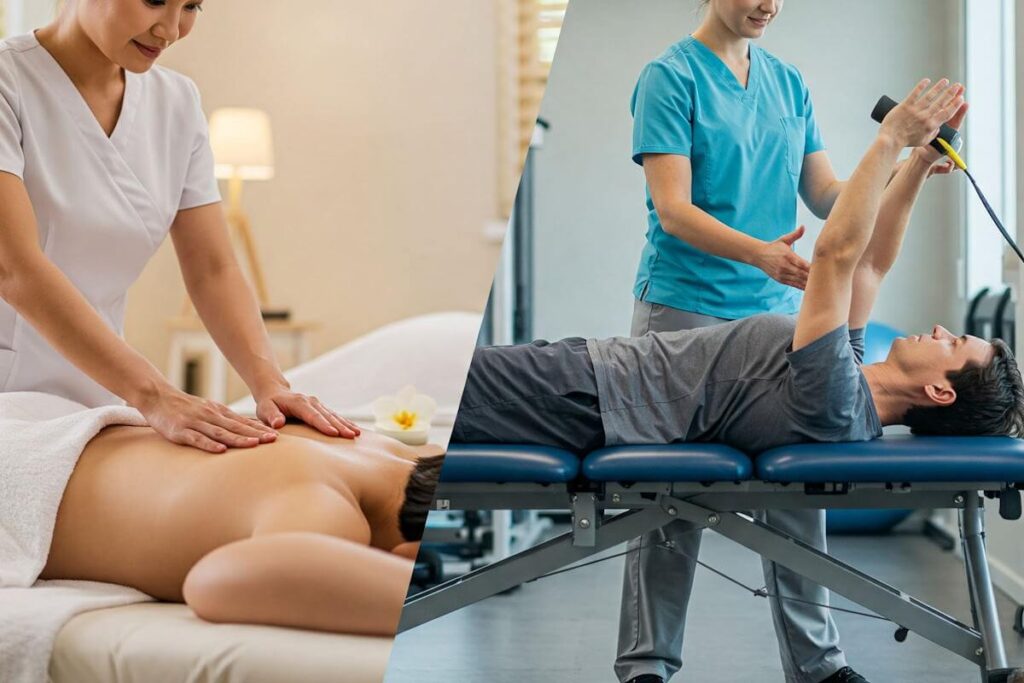Introduction to Prenatal Massage
prenatal massage is a specialized form of massage therapy tailored specifically for expectant mothers. This practice has gained substantial popularity in recent years as more individuals recognize the physical and emotional benefits it can provide during pregnancy. Unlike standard massage, prenatal massage techniques consider the unique physiological changes that occur in a woman’s body, ensuring a safe and effective experience.
The principles behind prenatal massage are rooted in the overall benefits of therapeutic touch, which has been shown to enhance relaxation, reduce pain, and alleviate stress. During pregnancy, a woman’s body undergoes numerous transformations, including weight gain, hormonal fluctuations, and changes to posture. These modifications can lead to discomfort, tension, and other physical ailments. Prenatal massage addresses these issues by focusing on key areas that bear considerable stress, such as the lower back, hips, and shoulders. By targeting these areas, the massage can help to improve circulation and promote relaxation, fostering an overall sense of well-being.
Moreover, this type of massage is conducted using specific techniques that ensure the safety of both the mother and the developing fetus. Certified therapists trained in prenatal practices are knowledgeable about the appropriate positioning of the mother and the use of supportive pillows to maintain comfort throughout the session. Additionally, certain massage techniques, such as gentle strokes and pressure point releases, are modified to avoid any potential risks during pregnancy.
In essence, prenatal massage is more than just a luxury; it serves as a valuable therapeutic tool for many pregnant individuals. As awareness of its benefits continues to spread, prenatal massage is being increasingly embraced by healthcare professionals, expectant mothers, and wellness practitioners alike. This growing acceptance underscores the significance of massage therapy during pregnancy and its role in promoting physical and emotional health for both mother and child.
Safety Considerations for Prenatal Massage
When considering prenatal massage, it is essential to prioritize safety for both the expecting mother and the fetus. While massage therapy can offer numerous benefits during pregnancy, certain precautions and contraindications must be meticulously observed. Initially, it is advisable for pregnant individuals to consult their healthcare provider before embarking on any form of massage therapy. This is particularly important for those with specific medical conditions such as high blood pressure, preeclampsia, or a history of preterm labor, as these conditions may necessitate a more cautious approach.
Contraindications for prenatal massage include, but are not limited to, pregnancy complications such as bleeding, placenta previa, or severe swelling of the legs. Additionally, if a woman has experienced a recent surgery or injury, it is imperative to seek medical clearance before receiving treatment. Understanding these potential risks is crucial in ensuring the safety and effectiveness of prenatal massage therapy.
Massage therapists must also adhere to established guidelines designed specifically for working with pregnant clients. It is vital that therapists remain informed about safe techniques and positions suitable for pregnancy, often avoiding areas such as the ankles and certain pressure points that are known to induce labor. Employing appropriate support, such as specially designed cushions and avoiding flat lying positions after the first trimester, can significantly enhance comfort and safety during the session.
By maintaining open communication between the therapist and the client, ensuring all health concerns are addressed, and adhering to safety protocols, prenatal massage can be a beneficial, safe practice. Ultimately, proper precautions are indispensable to facilitate a positive experience and safeguard the well-being of both the expecting mother and her baby.
Benefits of Prenatal Massage
Prenatal massage offers a wide range of benefits specifically geared towards the needs of expectant mothers. One of the most significant advantages is the alleviation of various pregnancy-related discomforts. As the body undergoes numerous changes, many women experience back pain, swelling, and muscle tension. Targeted massage techniques can help ease these symptoms, providing relief from the strain that often comes with carrying a growing baby.
In addition to physical comfort, prenatal massage plays a crucial role in enhancing relaxation and improving sleep quality. Expectant mothers often face challenges in finding a comfortable sleeping position due to their changing bodies. Through the soothing effects of massage, women can experience deeper relaxation, which can significantly contribute to better sleep. Improved rest is essential for both maternal and fetal health, helping the body recuperate and maintain energy levels.
Furthermore, prenatal massage serves as a powerful tool for reducing stress and anxiety levels. During pregnancy, emotional fluctuations are common, and many women feel overwhelmed due to upcoming responsibilities. Massage therapy encourages the release of endorphins, promoting a sense of well-being and calm. This emotional support is vital, as reduced stress not only benefits the mother but can also positively impact the baby’s development.
Overall, the benefits of prenatal massage can significantly enhance an expectant mother’s well-being. By addressing physical discomforts, fostering relaxation, and alleviating stress, prenatal massage can create a more positive and enjoyable pregnancy experience. This holistic approach to maternal care ensures that women feel nurtured, supported, and empowered during this transformative phase of life.
How Prenatal Massage Works
The effectiveness of prenatal massage can be attributed to various physiological and psychological mechanisms that contribute to the overall well-being of pregnant individuals. One of the primary effects of this specialized form of massage is improved circulation. As pregnancy progresses, increased blood volume and changes in the body’s posture can lead to decreased circulation in certain areas. Prenatal massage techniques, such as gentle kneading and stroking, help stimulate blood flow, delivering crucial oxygen and nutrients to both mother and fetus. Enhanced circulation not only alleviates common discomforts like swelling and fatigue but also supports fetal development.
Muscle relaxation is another significant benefit of prenatal massage. As the body undergoes various changes during pregnancy, it often experiences tension and tightness in areas such as the back, shoulders, and legs. Skilled massage therapists use techniques such as gentle stretching and focused pressure to release muscle tension, promoting a sense of calm and relaxation. This relief can also lead to improved posture, which is essential for reducing strain on the body as the pregnancy advances.
Moreover, prenatal massage stimulates the release of endorphins, the body’s natural painkillers and mood enhancers. This release helps combat feelings of anxiety and stress that are often prevalent during pregnancy. The soothing effects of massage can create a tranquil experience, providing psychological benefits that complement the physical advantages. Ultimately, understanding these mechanisms reveals why prenatal massage is not only safe but may also be a valuable addition to prenatal care, enhancing well-being for both the mother and her developing child.
Recommended Techniques for Prenatal Massage
Prenatal massage is a specialized form of bodywork designed to address the unique needs of expectant mothers. It primarily focuses on alleviating discomfort and promoting relaxation during pregnancy. When performing prenatal massage, it is essential to use techniques that are both effective and safe. Several methods stand out as particularly beneficial.
The Swedish massage technique is one of the most commonly recommended for prenatal sessions. This method involves gentle, flowing strokes that promote relaxation and improve circulation. It helps relieve muscle tension, especially in areas frequently affected by pregnancy, such as the lower back and legs. By incorporating long strokes and kneading, this technique can enhance overall well-being while ensuring the mother feels comfortable and supported.
Another technique worth considering is deep tissue massage. However, it should be approached with caution during pregnancy. Deep tissue work focuses on specific tension areas using more intense pressure. If performed by a trained professional, it can help alleviate chronic pain or tightness but should always be adapted to ensure the safety of both mother and baby. The therapist must be mindful of the pressure applied and should avoid sensitive areas.
Gentle pressure techniques, such as acupressure or reflexology, can also play a significant role in prenatal massage. These techniques can target specific pressure points, helping to relieve discomfort while promoting relaxation. Ideal for mothers who may have heightened sensitivity, gentle pressure can provide effective relief without causing strain.
Regardless of the technique chosen, proper positioning is crucial. Expectant mothers should be supported with appropriate pillows, ensuring they lie on their side or use a specially designed prenatal massage table. This positioning not only fosters comfort but also allows for better access to frequently affected areas, thereby optimizing the massage experience. Furthermore, always communicate with the client regarding their comfort and preferences to ensure a safe, effective session.
Pregnancy Stages and Massage Considerations
Pregnancy is a transformative period marked by various physiological changes that occur in a woman’s body throughout the three trimesters. Each stage presents unique considerations for prenatal massage, making it essential to tailor the approach according to the specific needs of the mother-to-be.
During the first trimester, many women experience symptoms such as nausea, fatigue, and emotional fluctuations. Although massage at this stage can alleviate stress and tension, care must be taken to avoid pressure points that could trigger contractions. A gentle, relaxing massage can help improve circulation and reduce tension, aiding in the overall physical and emotional well-being of the expecting mother.
In the second trimester, many women begin to feel better as the initial discomforts wane. This stage often brings a more noticeable baby bump, which may lead to increased discomfort in the back, hips, and legs. Prenatal massage techniques can be adapted to provide significant relief from these issues. This includes focusing on the lower back and pelvic areas while ensuring the expecting mother feels comfortable, often utilizing side-lying positions that relieve pressure on the abdomen.
As women enter the third trimester, the body undergoes even more changes, including increased weight and pressure on the joints. An experienced massage therapist can pay particular attention to areas that are prone to discomfort, such as the lower back, shoulders, and legs. Swelling is also common in this final stage, and massages can be beneficial in promoting circulation to reduce edema. It is vital to communicate openly with the therapist about comfort levels and any specific concerns, such as sciatica or pelvic pain.
In summary, understanding the distinctive shifts throughout pregnancy is essential when considering prenatal massage. Tailoring techniques to align with the varying stages ensures a comforting and beneficial experience for both the mother and the growing baby.
Finding a Qualified Prenatal Massage Therapist
When seeking a qualified prenatal massage therapist, it is essential to ensure that the practitioner is not only trained in massage therapy but also specializes in prenatal techniques. Begin by confirming their credentials, including certification from an accredited massage therapy program and any additional training in prenatal massage. Many states require a massage license, so verify that your therapist holds a valid license to practice.
Experience plays a crucial role in the effectiveness and safety of prenatal massages. It is advisable to select a therapist who has significant experience specifically in prenatal care. Inquire about the number of years they have been practicing and how many clients they have worked with during pregnancy. A skilled therapist will understand the physiological and emotional changes that occur during pregnancy and how to provide relief for discomfort associated with these changes.
Before scheduling an appointment, consider asking potential therapists several important questions to gauge their expertise and approach. Questions regarding their familiarity with common pregnancy-related issues, such as back pain or swelling, can provide insight into their ability to cater to your specific needs. Additionally, inquire about their techniques and whether they adjust their methods based on each client’s trimester and overall health status.
It can also be beneficial to seek recommendations or reviews from other expecting mothers. Their firsthand experiences can guide you towards reputable practitioners who have successfully provided care. If you have access to healthcare professionals, such as obstetricians or midwives, consider seeking their recommendations as well, as they often have connections with skilled massage therapists who specialize in prenatal care.
Ultimately, finding a qualified prenatal massage therapist requires diligence and research, ensuring that you select a professional who is both knowledgeable and compassionate, ready to support you during this crucial time.
Common Myths and Misconceptions
As prenatal massage gains popularity among expectant mothers seeking relief from pregnancy discomfort, several myths and misconceptions have emerged, potentially deterring individuals from exploring this beneficial therapy. One common myth is that prenatal massage is inherently dangerous to both the mother and the fetus. This belief stems from a historical viewpoint that associated all forms of massage with risks during pregnancy. However, when performed by a qualified practitioner trained in prenatal techniques, massage can be completely safe and even advantageous for both mother and baby.
Another misconception revolves around the idea that prenatal massage is only meant for relaxation, dismissing its therapeutic benefits. While relaxation is indeed a critical aspect, prenatal massage also targets specific issues such as back pain, swelling, and stress. By addressing these concerns, massage can enhance overall well-being throughout the pregnancy journey. Furthermore, some may erroneously think that prenatal massage is only appropriate in the later stages of pregnancy. In reality, it can be helpful in the second trimester and even earlier, provided the treatment is tailored to each stage of gestation.
Additionally, there are beliefs regarding certain body areas that should be avoided during prenatal massage, such as the abdomen or feet, due to fears of causing complications. In truth, reputable practitioners are trained to work the body thoughtfully and respectfully, skillfully avoiding any potentially sensitive areas. This ensures that the massage remains both safe and beneficial. The myths and misconceptions surrounding prenatal massage can create unnecessary fear. By debunking these misunderstandings, expectant mothers can better appreciate the value of prenatal massage as a safe and effective option for alleviating discomfort and enhancing their overall pregnancy experience.
Conclusion and Final Thoughts
As we conclude our exploration of prenatal massage, it is important to remember the multifaceted benefits it offers to pregnant individuals. Throughout this discussion, we have highlighted how prenatal massage serves as a valuable self-care tool, promoting physical well-being and emotional balance during pregnancy. The practice has been shown to alleviate discomfort, reduce anxiety, and provide overall relaxation, which are crucial during this transformative time.
Moreover, prenatal massage can help manage specific pregnancy-related issues, such as back pain, swelling, and muscle tension, allowing expectant mothers to maintain a higher quality of life. The combination of skilled touch and tailored techniques provides much-needed relief that can enhance both physical comfort and mental tranquility. Given the physical and emotional changes that occur throughout pregnancy, integrating this practice into one’s routine can significantly improve an individual’s sense of well-being.
However, it is essential for pregnant individuals to consult their healthcare providers before initiating any new wellness practices, including prenatal massage. This step is critical to ensure that such treatments are appropriate based on individual health conditions and circumstances. With professional guidance, expectant mothers can confidently choose qualified practitioners who specialize in prenatal massage and follow safety protocols.
Ultimately, regular prenatal massage can be an empowering element of a holistic approach to pregnancy care. Embracing this practice can support and nurture both the body and mind, promoting a positive pregnancy experience. As future mothers navigate the journey of pregnancy, considering the benefits of massage may add a valuable dimension to their self-care repertoire.




